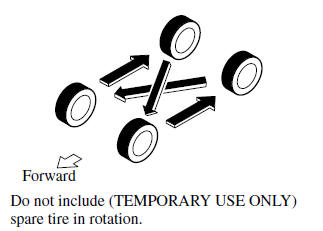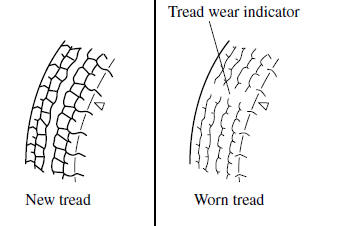Mazda CX-9 Owners Manual: Tires
For reasons of proper performance, safety, and better fuel economy, always maintain recommended tire inflation pressures and stay within the recommended load limits and weight distribution. WARNING Using Different Tire Types: Driving your vehicle with different types of tires is dangerous. It could cause poor handling and poor braking; leading to loss of control. Except for the limited use of the temporary spare tire, use only the same type tires (radial, bias-belted, bias-type) on all four wheels. Using Wrong-Sized Tires: Using any other tire size than what is specified for the vehicle is dangerous. It could seriously affect ride, handling, ground clearance, tire clearance, and speedometer calibration. This could cause you to have an accident. Use only tires that are the correct size specified for the vehicle. Tire Inflation Pressure WARNING Always inflate the tires to the correct pressure: Overinflation or underinflation of tires is dangerous. Adverse handling or unexpected tire failure could result in a serious accident. Use only a Mazda-genuine tire valve cap: Use of a non-genuine part is dangerous as the correct tire air pressure cannot be maintained if the tire valve becomes damaged. If the vehicle is driven under this condition, the tire air pressure will decrease which could result in a serious accident. Do not use any part for the tire valve cap that is not a Mazda-genuine part. Inspect all tire pressures monthly (including the spare) when the tires are cold. Maintain recommended pressures for the best ride, handling, and minimum tire wear. NOTE
Tire Rotation WARNING Rotate tires periodically: Irregular tire wear is dangerous. To equalize tread wear for maintaining good performance in handling and braking, rotate the tires every 12,000 km (7,500 miles). However Mazda recommends to rotate every 8,000 km (5,000 miles) to help increase tire life and distribute wear more evenly. During rotation, inspect them for correct balance.
Also, inspect them for uneven wear and damage. Abnormal wear is usually caused by one or a combination of the following:
After rotation, inflate all tire pressures to specification and inspect the lug nuts for tightness. CAUTION Rotate unidirectional tires and radial tires that have an asymmetrical tread pattern or studs only from front to rear, not from side to side. Tire performance will be reduced if rotated from side to side. Replacing a Tire WARNING Always use tires that are in good condition: Driving with worn tires is dangerous. Reduced braking, steering, and traction could result in an accident. Replace all four tires at the same time: Replacing just one tire is dangerous. It could cause poor handling and poor braking resulting in loss of vehicle control. Mazda strongly recommends that you replace all four tires at the same time. If a tire wears evenly, a wear indicator will appear as a solid band across the tread. Replace the tire when this happens.
You should replace the tire before the band crosses the entire tread. NOTE Tires degrade over time, even when they are not being used on the road. It is recommended that tires generally be replaced when they are 6 years or older. Heat caused by hot climates or frequent high loading conditions can accelerate the aging process. You should replace the spare tire when you replace the other road tires due to the aging of the spare tire. The period in which the tire was manufactured (both week and year) is indicated by a 4-digit number. Temporary Spare Tire Inspect the temporary spare tire at least monthly to make sure it is properly inflated and stored. NOTE The temporary spare tire condition gradually deteriorates even if it has not been used. The temporary spare tire is easier to handle because of its construction which is lighter and smaller than a conventional tire. This tire should be used only for an emergency and only for a short distance. Use the temporary spare tire only until the conventional tire is repaired, which should be as soon as possible. CAUTION
NOTE Tires degrade over time, even when they are not being used on the road. It is recommended that tires generally be replaced when they are 6 years or older. Heat caused by hot climates or frequent high loading conditions can accelerate the aging process. You should replace the spare tire when you replace the other road tires due to the aging of the spare tire. The period in which the tire was manufactured (both week and year) is indicated by a 4-digit number. Replacing a Wheel WARNING Always use wheels of the correct size on your vehicle: Using a wrong-sized wheel is dangerous. Braking and handling could be affected, leading to loss of control and an accident. CAUTION A wrong-sized wheel may adversely affect:
NOTE
Proper tire balancing provides the best riding comfort and helps reduce tread wear. Out-of-balance tires can cause vibration and uneven wear, such as cupping and flat spots. |
See More:
Mazda CX-9 Owners Manual > If Trouble Arises: Overheating
Overheating If the temperature gauge indicates overheating or the high engine coolant temperature warning light turns on, the vehicle loses power, or you hear a loud knocking or pinging noise, the engine is probably too hot. WARNING Pull over to a safe location, then switch the ignition off and make ...




